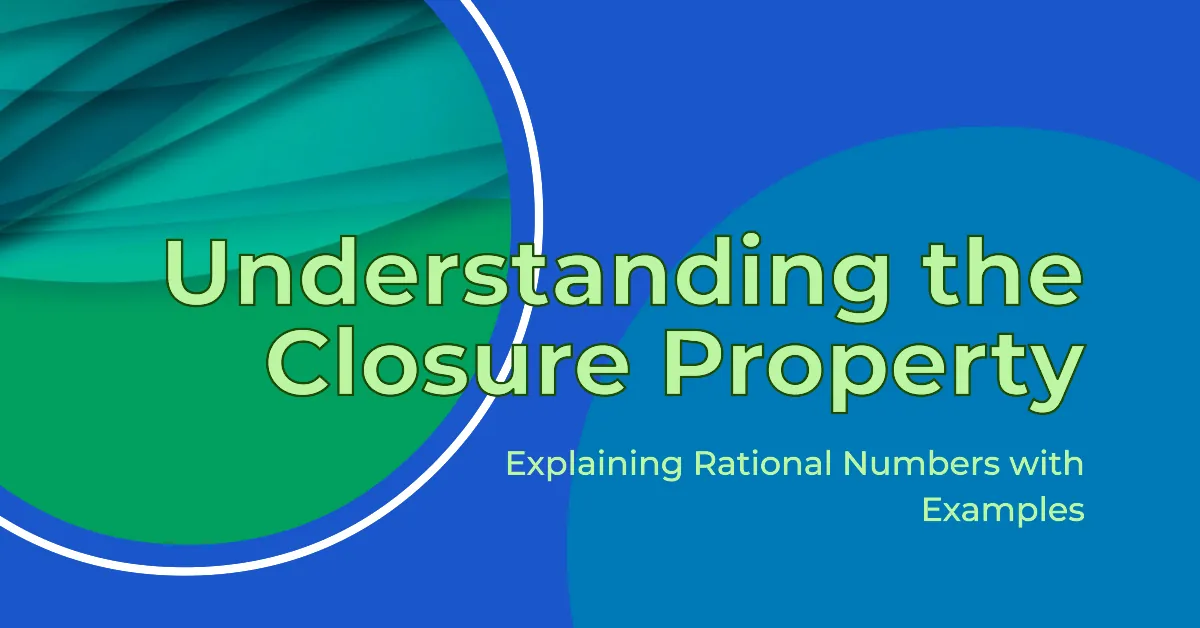Rational numbers are a fundamental part of the number system in mathematics. They are numbers that can be expressed as a quotient or fraction of two integers, where the denominator is not zero. The set of rational numbers is denoted by the symbol Q. One of the key properties of rational numbers is the closure property.
Understanding the Closure Property
The closure property refers to the ability of a set of numbers to produce a result within the same set when a specific operation is performed on them. In the context of rational numbers, this means that when you perform basic arithmetic operations (addition, subtraction, multiplication, and division) on any two rational numbers, the result will always be a rational number. This is known as the closure property of rational numbers.
Closure Property of Addition
The closure property under addition states that adding two rational numbers always results in another rational number.
For example, if you add two rational numbers 2/3 and 3/5:
2/3 + 3/5 = (2 x 5 + 3 x 3) / (3 x 5) = 19/15
Here, adding the rational numbers 2/3 and 3/5 yields 19/15, which is also a rational number. This demonstrates that the set of rational numbers Q is closed under addition.
Closure Property Under Subtraction
The closure property under subtraction states that subtracting one rational number from another always results in another rational number.
For example, if you subtract two rational numbers 3/8 and 1/4:
3/8 – 1/4 = (3 x 4 – 1 x 8) / (8 x 4) = 4/32 = 1/8
The difference 9/32 is a rational number, showing closure under subtraction.
Closure Property of Multiplication
The closure property under multiplication states that the product of any two rational numbers is also a rational number.
For example, if you multiply two rational numbers 1/2 and 2/7:
1/2 x 2/7 = (1 x 2) / (2 x 7) = 2/14 = 1/8
The product 7/14 is a rational number, demonstrating closure under multiplication.
Closure Property of Division
The quotient of two rational numbers is a rational number, provided that the divisor is not zero.
For example, if you divide two rational numbers 5/6 and 1/3:
5/6 / 1/3 = (5 x 3) / (6 x 1) = 15/6 = 5/2
5/2 is a rational number, showing the closure property under division.
Some key points about the closure property of rational numbers:
- It applies to the operations of addition, subtraction, multiplication and division
- It means performing these operations on rational numbers always results in another rational number
- Fractions and ratios of integers are the reason for this closure property
- Not all number systems are closed under these basic operations (e.g. real numbers are not closed under division by zero)
The reason rational numbers have this closure property is because they can be expressed as fractions, which are ratios of integers. When you perform arithmetic on fractions, the result is reduced to lowest terms and becomes another fraction of integers.
Exceptions to the Closure Property
While the closure property holds for addition, subtraction, and multiplication of rational numbers, there is an exception when it comes to division. The set of rational numbers is not closed under division if the divisor is zero. This is because division by zero is undefined in the number system.
For example, let’s consider two rational numbers, say 5/3 and 0. According to the closure property, the result of dividing these two numbers should also be a rational number. However, when we try to divide 5/3 by 0, we encounter a problem.
Mathematically, division by zero is undefined. This means that we cannot find a rational number that we can multiply by 0 to get 5/3. Because of this, we say that the set of rational numbers is not closed under division when the divisor is zero.
Closure Property Examples
Here are some mathematical expressions related to the closure property of rational numbers:
- Addition: If a and b are rational numbers, then a + b is also a rational number. For example, if a = 2/3 and b = 1/2, then a + b = (2/3) + (1/2) = 7/6, which is also a rational number.
- Subtraction: If a and b are rational numbers, then a – b is also a rational number. For example, if a = 5/7 and b = 3/8, then a – b = (5/7) – (3/8) = 29/56, which is also a rational number.
- Multiplication: If a and b are rational numbers, then a x b is also a rational number. For example, if a = 3/5 and b = 2/7, then a x b = (3/5) x (2/7) = 6/35, which is also a rational number.
- Division: If a and b are rational numbers and b ≠ 0, then a / b is also a rational number. For example, if a = 5/3 and b = 1/4, then a / b = (5/3) / (1/4) = 20/3, which is also a rational number.
So in summary, the set of rational numbers is closed under the four basic arithmetic operations of addition, subtraction, multiplication, and division (excluding division by zero).
Conclusion
The closure property is a fundamental characteristic of rational numbers that helps us understand the results of arithmetic operations. It assures us that the sum, difference, product, and quotient (except when the divisor is zero) of any two rational numbers will always be a rational number. This property is not only crucial in basic arithmetic but also plays a significant role in more advanced mathematical concepts.

